
Pre-cut Biscotti on left, Keto rolls on right. Both made from almond meal.
Really, how did I survive before almond meal? First, let me clear up that it’s not the same as almond flour, but pretty darn close. They’re both finely ground almonds. Almond meal tends to be slightly courser while almond flour is finer and is made from blanched almonds, meaning the skin has been removed. But for recipes that call for almond flour you can substitute almond meal. And I do, it’s cheaper and I like the really nutty flavor. I buy it at Trader Joe.

I’ve probably posted almond meal recipes before, but now it’s like we can’t get enough of it here in this house. Ever since I started making this Keto bread, the husband has put in an order for another six rolls almost every other day. That, from a man who grew up in the Netherlands which he never fails to tell me is, “bread country.”
And then there’s the almond meal pizette, (below) which substitutes for an incredible pizza and a quick meal when we get home late from somewhere, or I’ve just run out of ideas for dinner. Or I make it as a starter and it’s so satisfying and filling, the main gets put away.
The defining touches on this pizza crust are slathering artichoke antipasto (also from Trader Joe) and just a bit of cheese, your choice, on it after you bake it the first time and before it’s second bake. And when it’s completely done, top it with pesto, which I make myself these days, thank you, or fresh arugula. We also like some chili flakes on top.

In my formative, fatter years, teens, twenties, thirties, if you told me I would have to give up my scones, croissants and corn muffins I would have cried and then cried some more. Big, salty tears.
Now, granted if I’m in France, I will during the trip have a croissant. If I”m in the U.K., I will have a scone. And I will enjoy the heck out of them. But here at home, nada, never.
I am so content with living in a world of almonds the thought never crosses my mind. Now keto bread with almond butter? To die for, or actually just the opposite. This stuff barely nudges the blood sugar. In fact, I’m more likely to overshoot for it, a lesson in the making, or should I say baking?
Here are three more recipes worth biting into – almond meal biscotti, the flax muffin you make in a mug and life-changing bread.
They’ve all changed my life and made it oh, so delicious.




